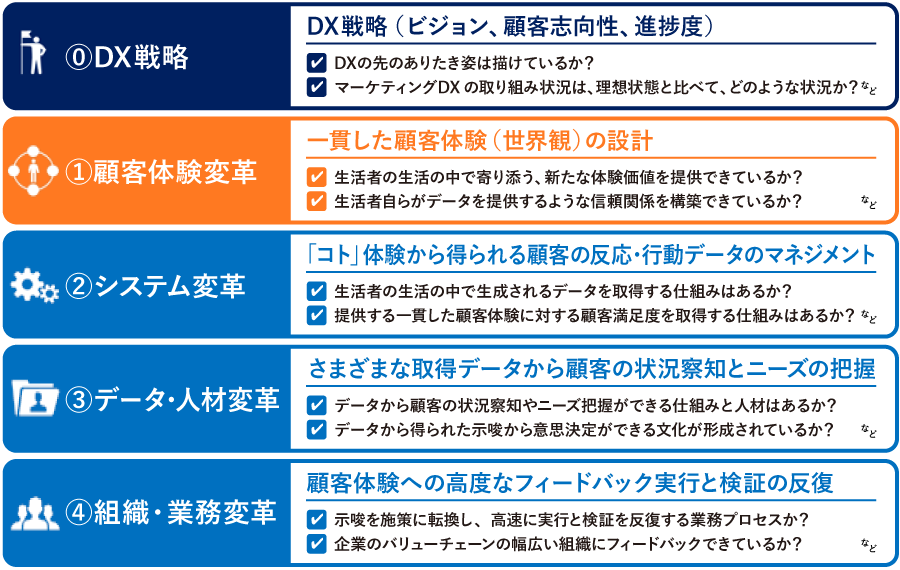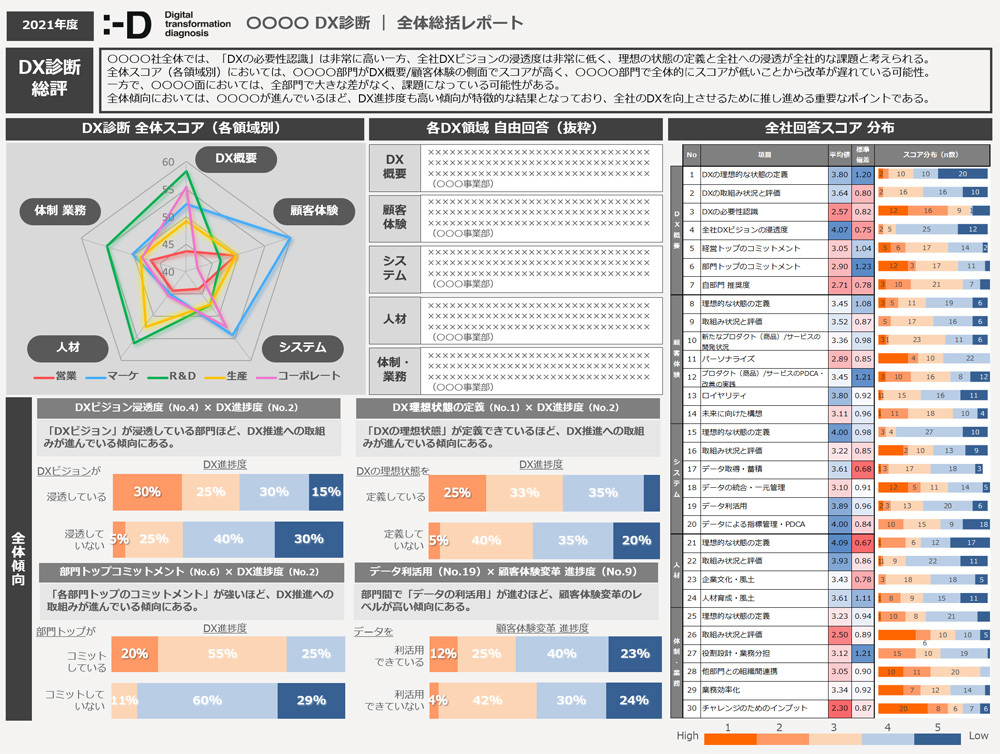Leveraging its accumulated expertise in people-centric marketing, Dentsu Inc. defines and supports the digital transformation (DX) of client customer touchpoints as "Marketing DX."
In September 2020, Dentsu released the "Dentsu Digital Transformation Diagnosis" (hereafter, DX Diagnosis). This tool clarifies the "current state" of a company or business's DX progress across the following key areas.

Part of the diagnostic items. To analyze clients' DX from multiple angles, we prepared a questionnaire consisting of 32 items across three perspectives and four domains. DX challenges are quantified and diagnosed based on client responses.
Furthermore, in July 2021, we released the "Dentsu Digital Transformation Diagnosis for Internal Divisions" (hereinafter referred to as the DX Diagnosis for Internal), focusing specifically on the "④ Organizational and Operational Transformation" aspect of the above DX Diagnosis. This diagnosis aims to enhance company-wide DX awareness and drive progress by relatively visualizing and understanding the challenges within each internal department.
In this article, continuing from the previous installment, Akiko Kosugi from Rohto Pharmaceutical's DX Strategy Design Division is interviewed by Akihiko Miura from Dentsu Inc.'s Business Transformation Division. They introduce the overview of the "DX Diagnosis for Internal Divisions" and present the case study of Rohto Pharmaceutical, which implemented this diagnosis, to convey its benefits.
Seeking to visualize each department's "hidden DX challenges," the decision was made to implement the diagnosis.
Miura: The background for developing the "DX Diagnosis for Internal" stems from feedback we frequently received while supporting various companies in the DX domain. These included: "We don't know which departments are advancing DX and which aren't," "We don't know how to advance DX at the departmental level," and "Although we belong to a specialized DX promotion department, other departments' awareness of DX promotion remains low."
Therefore, we wanted to create a new diagnostic tool that could delve deeper into and analyze the challenges related to DX across each internal organization. In fact, we had been working on such a diagnostic format for several years, so we leveraged that expertise to design a diagnostic tool capable of serving a wider range of companies. Why did your company decide to implement the "DX Diagnosis for Internal"?
Kosugi: There are several reasons, but first and foremost, after undergoing the company-wide "DX Diagnostic," we saw our own lack of progress in DX broken down and visualized, which was expected but still significant. We realized a major issue was the lack of definition: what exactly is "DX at Rohto Pharmaceutical?" and where we need to invest people, power, and resources.
We also sensed inconsistencies across departments. In my work at the DX Strategy Design Headquarters, departments with visible challenges reach out to us for consultation, and we can explore countermeasures. However, some departments never consult us. I suspected their challenges were buried.
That's why I requested a department-level DX diagnosis. Having previously experienced your company's "DX Diagnosis," I recognized your robust analytical framework based on solid algorithms. When I consulted you about this, I learned you were timing the release of "DX Diagnosis for Internal" perfectly, so we decided to proceed.
Miura: Thank you. With 'DX Diagnosis for Internal,' each client department answers 35 questions across 4 domains, designed based on Dentsu Inc.'s DX consulting expertise. We then analyze organizational trends and departmental situations regarding DX. As diagnostic results, we provide an overall summary report and department-specific reports.
Overall Summary Report Image

Departmental Report Example

To conduct the diagnosis, each department needed to answer the questionnaire. How did you get everyone to respond?
Kosugi: Primarily, we had each department head respond as the representative. However, we strictly required that the responses be considered by leaders or managers at the department level or above. We insisted they discuss and confront the question: "What is the state of DX within their own department?" Since there was also a top-down directive to promote DX at the time, most departments actively engaged with the process.
I wanted to share my own experience from taking the "DX Diagnosis" – where I confronted my company's DX situation, thought through my answers, and gained insights – with leaders and above in each department. This approach stemmed from that desire, and I feel it successfully permeated the awareness of DX promotion within each department.
In some departments, the assessment prompted all members to spontaneously hold discussions about DX, creating opportunities for each member to consider "What does DX mean for our department?"
Some departments even began taking initiative toward next steps before the diagnostic results were finalized.
Miura: The questionnaire was designed to include open-ended questions for a more detailed analysis of each department's situation. This time, we received detailed responses from many departments, and I could really feel the heightened awareness of DX promotion within your company.
Kosugi: Since we requested responses from 44 departments, I was a bit concerned whether all would return them by the deadline. As a member responsible for DX promotion, I was very pleased that all departments responded properly by the deadline.
We've also received positive feedback, such as: "It was good to really think about our department's DX," and "We'll submit our questionnaire responses first, but we plan to separately organize our department's DX status going forward." I strongly feel this wasn't just about completing the questionnaire; it became a catalyst for each department to consider their next steps.
Miura: I see this diagnostic as a catalyst, or rather, a push to get things started. The crucial first step is getting each department to think about their own company's DX. That action itself is the trigger needed to address challenges like "DX promotion awareness not being ingrained company-wide." In that sense, it's an ideal situation that after receiving the diagnostic, each department is now thinking and acting independently.
Kosugi: Actually, there was another secondary effect. The questionnaire includes questions about "customer experience," but for some departments, it can be difficult to visualize who that "customer" is. For the marketing department, customers are always at the forefront of their work. However, for internal support departments like accounting, HR, and general affairs, their "customers" are directly the company's own employees.
Conducting this diagnostic provided an opportunity for departments that rarely considered who their customers were to rethink this. Support departments began contemplating what value they could provide to employees, which ultimately always leads to positive impacts on customers. We hadn't initially imagined such far-reaching effects, so this was a major gain.
Miura: In advancing DX, your company clearly emphasized "properly seeing the customer," right? When implementing this "DX Diagnosis for Internal," I also sensed a strong stance of no exceptions across all departments. Precisely because the diagnostic questionnaire asked about customers, it likely provided the driving force for DX advancement.
Kosugi: As an action for DX promotion this term, we had all employees, including those working on factory production lines, take a DX literacy course. We aim to build a common language and mindset among employees as we advance DX, and use that to drive the next steps.
Factors related to our company's DX challenges and trends were clarified, and inter-departmental "competitive spirit" also provided a boost.
Miura: The "DX Diagnosis for Internal" provides an overall summary report that visualizes the status and trends of initiatives across all departments by area. This helps identify initiatives impacting DX promotion and outcomes, and grasp trends in challenge areas. The department-specific report allows each department to understand its relative position and identify which DX areas it is ahead or behind in, using deviation scores and evaluation grades (S to C). It also calculates each department's DX progress level in terms of overall ranking and ranking within its own department, fostering DX awareness. Please share your thoughts and opinions after reviewing the diagnostic results.
Kosugi: First, looking at the results by area, I was surprised to see unexpected situations. Areas I thought were advancing well in DX were at the average level, while areas I thought weren't progressing much stood out significantly. While accepting the results, I also consider that the diagnosis is based on "self-assessment." This provided us with a lot of material for reflection, including how the respondents made their judgments.
Beyond the individual results, the clear visualization of the overall situation was crucial. We also identified significant correlations with specific questions, revealing key trends in our DX efforts. These questions helped pinpoint the essential minimum conditions needed to drive future DX initiatives. This clarity allows us to infer "where each department should focus its efforts," which is very positive.
Miura: Thank you. Visualizing the key focus areas for achieving our goals and the challenges by department, while clearly defining each department's current position, fosters a competitive spirit. This competitive drive itself can become a key engine for advancing DX.
In response to numerous inquiries, we have enhanced and expanded Dentsu Inc.'s DX diagnostic solutions into a series. The " DX Diagnostic " introduced previously is a tool for broadly visualizing corporate DX challenges. Furthermore, this year we released the " DX Diagnostic for Internal," specialized for internal organization and operations, and the " DX Diagnostic for Systems, " focused on the systems domain. If you are interested, please feel free to contact us.
[Contact Information]
Marketing DX Diagnostic Team info.dx@dentsu.co.jp












